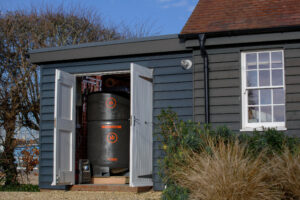It’s hotting up: The race to decarbonise heat

A quick glance at power emissions or electric vehicle (EV) sales gives the impression the UK is on the fast track to net zero. But when attention turns to heating, we are still tentatively making our way over the first few hurdles. The picture is similar across Europe. Engineers and innovators have developed a range of different sustainable solutions for the heating market. The task now becomes communicating with the public and bringing them onboard the decarbonisation of heat journey.
This blog will walk you through four ways we can decarbonise heating and the communications challenges they face.
Heat pumps
There are three types of heat pump; air, water and ground source. Aside from the space needed, the technology around them is largely the same. The simplest way of thinking about them is a fridge in reverse. Heat is pulled from the air, the water, or the pipes in the ground and transferred to a coolant and then compressed using electricity. It’s the compression here that generates the heat to warm your home.
Heat pumps typically pump round water that’s slightly cooler than the system you’ll have now. This makes reducing draughts and heat loss vital. New builds and well-insulated houses will still feel warm with a heat pump, but your heating will likely be on for longer.
This is one communication challenge, but grid concerns also need addressing. Adding demand to the grid in winter, when it’s already higher, leaves some to argue electrification of heating is not the right approach. The industry needs to counter this concern and celebrate the additional grid flexibility heat pumps can offer, especially given the hidden costs of flexibility.
District heating
District heating or heat networks typically supply heat to local homes or buildings from a central plant through a network of pipes. Quite often, these are thought of using combined heat and power plants (CHP) or biomass boilers but the innovation hasn’t stopped there! I’m sure many of you are familiar with the heat you feel on the Northern line – well, that waste heat is heating homes and schools in Islington thanks to district heating.
That is part of the problem with district heating, though, whether CHP or waste heat it’s best used in crowded city areas where off-takers are close by. Heat doesn’t transport as efficiently as electricity or hydrogen.
Unlike heat pumps, individual customers can’t decide to go green and join a district heating network. But there lacks the pressure for more heat networks to be installed. European cities lead the way in embedding district heating into city plans, so proving the technology works isn’t the communications challenge. Creating a desire for change, and following our European neighbours is where the challenge lies.
Hydrogen
You’ll be hard-pressed to avoid talk of hydrogen at the moment – whether using electrolysis for surplus renewable energy or in oil and gas facilities – it’s definitely the buzzword. This excitement is also spilling into the heating debate.
Trials are underway to add a blend of hydrogen, including at Keele University, into the gas grid so current boilers can still be used, but ultimately to run on a 100% hydrogen system we’ll need to install new boilers into homes. Although still using existing gas infrastructure, a retrofit challenge of this nature will require some clear and concise communications. The digital switchover for televisions might just be a better model than the smart meter roll-out. Boilers are rarely a decision made with the luxury of time – they break and we need to replace them. Whether it’s being ready for that decision with hydrogen-ready boilers on the shelves or convincing people to trade up before it breaks, the messages need to start landing now.
I won’t get into the blue, green, grey hydrogen debate but that presents another area for communications to focus on.
Heat batteries
Heat batteries are a newer innovation to the heating market – in fact, Caldera has just closed a crowdfunding round to help with proving the concept, so don’t expect to install one in time for this winter.

Photograph : Luke MacGregor
Heat batteries work in a similar way to a thermos flask – vacuums keep the water hot until it is needed to be pumped around the home. Like a heat pump, electricity is their fuel, but a quick heating response is available on-demand, more like your traditional heating system.
They’re likely to be suited to older, draughtier homes as consumers can make a greener choice today, without the upfront cost of insulation or underfloor heating you will likely need with a heat pump.
The heating market is being disrupted, so heat batteries are less able to claim they are the disrupter with their communications narrative work, but as a new technology, they’ll need to quickly carve out their niche to prevent heat pumps stealing a march on their potential customers.
Regardless of technology, green heating needs to take centre stage both in the UK and beyond. Get in touch to find out how we can help shape your messaging and deliver a communications campaign to take customers from prospect to warm lead.

